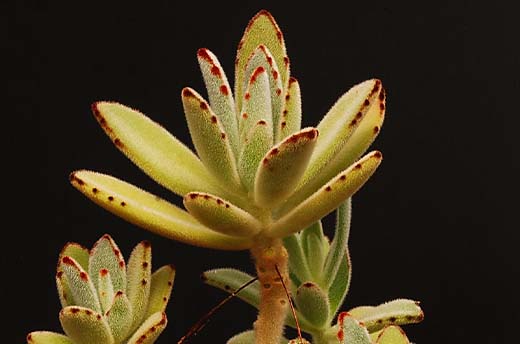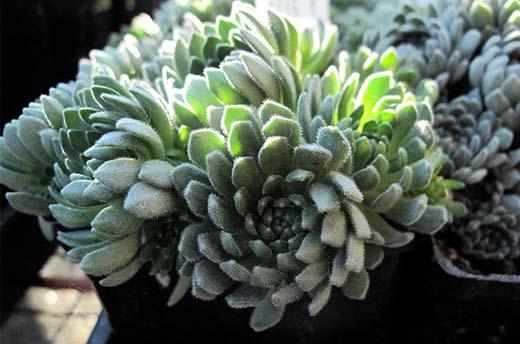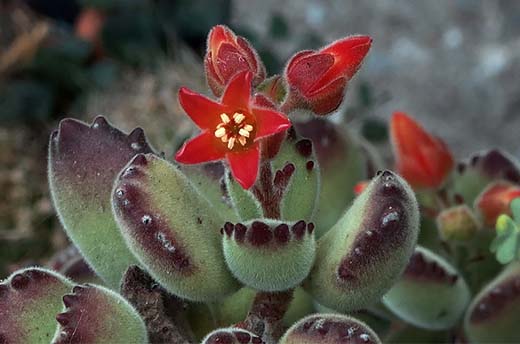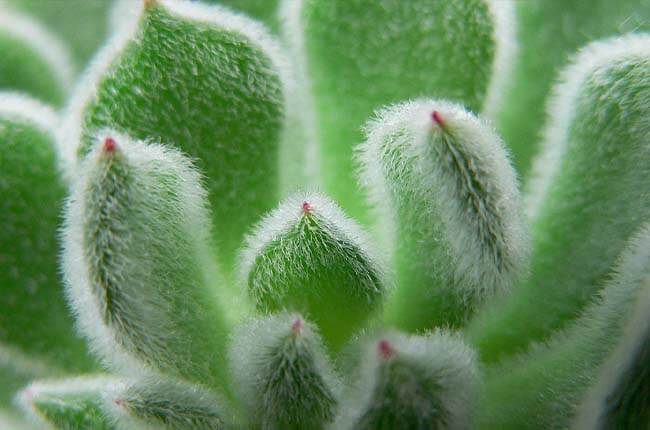If you think succulents are the cutest thing ever, you will love the ones with furry, velvet-like leaves that are covered in tiny white hairs.
The white fuzzy outgrowths on leaves and stems are “trichomes”, which can be short, fine threads, or tufts of hair branching out like a star. They serve to protect the plant against sunburn, moisture loss, and pathogens, making it more drought and sun-resistant.
In this article, we take a deeper look at the special functions it serves, the common succulents with such a unique feature, and what special care they need.
1. What is the fuzzy stuff on some succulents?
The fuzzy, velvety structures are “trichomes” which are outgrowths on the epidermis of all parts of a plant. They exist in different shapes and sizes depending on the species.
A study of 20 species of Kalanchoe found eight different types of trichome structures of different shapes (Weryszko-Chmielewska & Chernetskyy, 2005).
Some trichomes are in the form of hairs which can be simple, fine elongated threads, or tufts of hair branching out like a tree or a star and they are often smooth and soft to touch. Other trichomes are stalk-like protrusions with heads with secreting glands to produce oils.
Trichomes exist not only for succulents but in many different plants, e.g. mint, lavender, tomato, pineapple, naranjilla, cannabis, cape sundew, garden huckleberry.
2. Why do some succulents have hair?
2.1 Protect against sunburn
The dense distribution of trichomes on the leaf surfaces serves to block some of the UV light and protect the plant against sunburn.
This is particularly important because most succulents grow in semi-arid and open environments where they are exposed to direct sunlight.
2.2 Protect against moisture loss
The hairs on the plant trap a thin layer of still air around the plant, thus reducing airflow and preventing water evaporation.
2.3 Protect against insects and fungal infection
Succulents in the wild are usually exposed to attacks by different insects such as mealybugs, aphids that feed on the plant by sucking the juice.
The dense layer of hair acts as a protective barrier that prevents pathogens from reaching the plant’s epidermis.
3. List of fuzzy succulents
3.1 Kalanchoe Tomentosa (“Panda plant”)
Also known as Panda plant, Kalanchoe Tomentosa has dark green leaves with a silvery-white coating of fine hairs and reddish-brown leaf tips.
It prefers full sun and can grow up to about 2 feet (61 cm) tall when fully matured.

3.2 Kalanchoe Orgyalis (“Copper Spoons”)
Its leaves are oval-shaped with spade-like tips and are covered with brown cinnamon hairs.
It usually grows up to 12 inches (30.48 cm) tall.
3.3 Sempervivum Arachnoideum (“Cobweb Hen-and-chicks”)
Also known as “Cobweb hen-and-chicks”, this plant is green rosettes covered in white, hairy webrings.
It grows up to 3 inches (7.62 cm) tall. It forms pale green rosettes that grow up to 4 inches (10.16 cm) wide. It is covered by dense cobweb-like white hairs.

3.4 Kalanchoe Eriophylla (“Snow White Panda Plant”)
This small plant grows up to 12 inches (30.48 cm) tall. Its stems and leaves are green, but all of it is covered with white wooly hair. Its leaves can turn reddish when sun-stressed in winter.
3.5 Echeveria Setosa (“Mexican firecracker”)
The beautiful “firecracker” succulent has thick fleshy spoon-shaped leaves covered in soft and thick white hairs.
Its small stemless rosettes can reach up to 4 inches (10.16 cm) tall and spread up to 19 inches (48.26 cm) wide.

3.6 Kalanchoe Beharensis (“Elephant Ear” or “Felt Bush”)
Its green leaves are triangular-shaped and crinkled on the sides. It also has slender woody stems.
It can grow up to 12 ft (3.6 m) tall, almost as big as a small tree.
3.7 Sempervivum Ciliosum (“Teneriffe houseleek”)
Also known as Teneriffe houseleek, this succulent is a rosette of pointed leaves covered in fine white hairs, giving it a velvety look.
It can grow up to around 4 inches (10cm) tall and 20 inches (50cm) wide.
It belongs to the stonecrop family and is found growing on cliffs, on silicate rocks, near river native to Southeastern Europe.

3.8 Echeveria Harmsii (“Ruby Slippers”)
This succulent is amazing not only with its green hairy leaves with reddish-pink edges, but also its orange flowers.
This plant can grow up to 12 inches (30.48 cm) tall. It has a woody stem with paddle-shaped leaves.
3.9 Tradescantia Sillamontana (“Cobweb Spiderwort”, “White Velvet”, “White Gossamer plant”, or “Hairy Wandering Jew”)
This unique succulent has green leaves in ranks of two that are covered in cobweb-like hairs.
It has unique purple flowers and is a tall fuzzy succulent that can grow up to 18 inches (45.72 cm) tall.
3.10 Cotyledon Tomentosa (“Bear Paws”)
This succulent features thick fleshy green leaves with reddish-brown leaf edges and small deep red flowers.
It is usually small, but it can grow up to 27 inches (68.58 cm) tall when fully matured.

3.11 Cyanotis Somaliensis (“Pussy ears”, “Kitten ears”, and “Furry kittens”)
This succulent has long pointed leaves looking like cat ears, with fleshy stems that are hidden beneath its leaves.
It grows up to 8 inches (20 cm) tall.
4. Special care for fuzzy succulents
Avoid pouring water on the leaves to prevent droplets of water from accumulating on the hairs.
When exposed to sunlight, these droplets can act as tiny magnifying glasses and can burn off the hairs.
Other than that, caring for the fuzzy succulents is similar to that for other succulents. Because of their hairs, fuzzy succulents are more drought-resistant and prefer a growing medium with good drainage.
Water only when the soil is dry.
Fuzzy succulents are some of the hardiest succulents. Most of them prefer warm temperatures from 60 to 80°F (15 to 26.6°C), but some species can even thrive in extreme temperatures of 40 to 90°F (4.4 to 32.2 °C).
They are also sun-resistant and prefer a stronger light environment.
If your succulent shows signs of insufficient light (e.g. etiolated stems), you can use grow lights.
5. How to get dirt out of fuzzy succulents?
Use a small soft-bristled paintbrush to brush off the dirt. Do it gently to prevent damaging the hairs or trichomes.
Also, make sure that the brush is dry before using it to prevent water from accumulating on their hair.
6. Are Fuzzy Succulents Poisonous?
Most fuzzy succulents are safe for humans and pets, except the genus of Kalanchoe, specifically Kalanchoe Tomentosa, Kalanchoe Eriophylla, and Kalanchoe Orgyalis which are toxic to cats and dogs.
Kalanchoe’s toxicity is due to a group of bufadienolide compounds. These are naturally produced chemicals that have toxic properties.
The lethal dose in small animals is not known. But in calves, it is estimated to be 0.24 oz (7oz) of flowers/kg body weight or 1.41 oz (40 g) of leaves/kg body weight.
When ingested, initial symptoms such as excessive salivation, vomiting, and diarrhea can manifest within a few hours. As the condition continues; it can lead to stomach bleeding, abnormal heart rhythms, and weakness.
At its final stage, it will turn into cardiac arrest and the animal dies.
The poisoning is very rapid and can take 12-24 hours. However, it may also continue for 4 to 5 days in some cases.
When your pet ingests a piece of Kalanchoe, bring your pet immediately to a veterinarian for emergency treatment.
Conclusion
In conclusion, some succulents develop hairs or trichomes on their surfaces for protection against the external environment. Their hairs make them some of the most drought and sun-resistant plants.
Because of that, fuzzy succulents are easy to take care of.
Happy growing!
Photo credits
“Echeveria_setosa_minor_E312_061107_2” by Enez35 is licensed under CC BY 2.0
“Kalanchoe tomentosa.” by graftedno1 is licensed under CC BY-ND 2.0
“Kalanchoe tomentosa cv. ゴールデンラビット(2/2)” by salchuiwt is licensed under CC BY-SA 2.0
“sempervivum ciliosum” by MeganEHansen is licensed under CC BY-SA 2.0
“Echeveria setosa” by laurent7624 is licensed under CC BY-SA 2.0
“J20170918-0007—Cotyledon tomentosa—DxO” by John Rusk is licensed under CC BY 2.0
References
Missouri Botanical Garden. Insect pests of cacti and succulents grown as house plants.
Cactus & Succulent Society of San Jose. Cactus and Succulent Care for Beginners.
Royal Horticultural Society. Echeveria setosa.
National Parks Singapore. Cotyledon tomentosa Harv.
American Society for the Prevention of Cruelty to Animals. Kalanchoe.
Weryszko-Chmielewska, E. & Chernetskyy, M. (2005). Structure of trichomes from the surface of leaves of some species of Kalanchoe Adans. Acta biologica Cracoviensia. Series botanica, 47(2):15-22
- Keiki Paste vs Rooting Hormone:What’s the difference? - February 4, 2024
- Top 10 Orchid Fertilizers: A Comprehensive Review (2024) - February 2, 2024
- Top 8 Soil Inoculants For Stronger Plants (2024) - February 1, 2024


